Reading Time: ~15 minutes (Or about the average Chipotle wait time)
“It ain’t what you don’t know that gets you into trouble. It’s what you know for sure that just ain’t so.”
If you feel like you’ve seen this quote somewhere, don’y worry, you’re not crazy (at least not for that reason.) (i.e. You might still be crazy, I’d look into it) (i.e. “No, we get it, Justin, please get back to f%8king article!”). (I.e. Roger that.)
The reason you might recognize the quote is that it came on the screen along side the opening credits to the movie, The Big Short. Of course, there, the implication had to do with the unfounded confidence (or blatant insidiousness) of bankers, lenders, and various credit-rating agencies that contributed toward the 2008 crash. In this post, I am indicting another industry: one I will refer to broadly as “Nutrition.”
Over the past decade+ I have been obsessing over this field in search of what I would call “Optimal Nutrition.” Optimal Nutrition is simply the foods we should eat that lead to the highest probability of living the longest, and healthiest, possible lives – what researchers call the longest “Healthspan.”
Notably, a Healthspan is distinguished from a lifespan because it isn’t that you merely “make it” to 100. It is that you are vital and vigorous mentally and physically until your last breath, or as close to that as possible.
Over the last decade of research and self-experimentation – talking to various experts, reading the books and research articles, and trying them on myself – I have made progress on my quest to discover Optimal Nutrition, but I have hit a few speed bumps.
And no speed bump has been larger or more jagged than the negligently (or intentionally) mis-paved mountain of, as the Twain quote puts it: “know[ing] for sure [what] just ain’t so.” That is, the largest barrier to discovering Optimal Nutrition might be the age-old mistake of claiming, as fact, something that is far from certain.
The medical and psychological fields have a name for a similar concept: the “False Positive.” A False Positive in medicine, for example, is when you are incorrectly diagnosed with a condition that you do not actually have. It results from either negligence (incorrect interpretation of data) or, if you’re a cynic, ill-will (people intentionally warping the data to accomplish some end).
In this post, I will leverage the research and experts to explore:
-
How we might be “Knowing what ain’t so” in Nutrition
-
Explore why nutrition might be uniquely at risk for this problem, and
-
How to navigate this issue on our way to discovering a framework for Optimal Nutrition
But first, I think it useful to explore just how long this idea credited to Twain has been around. And to do that, we’ll have to jump in the Dolorian and head back to the future… I mean past.
[NOTE: If you want to skip ahead to (i.e. I hate you) (i.e. Jk, lol, brb) the Nutrition part, thumb down to section #2. If you’re reallllyyyyy busy (oooo you’re sooo importantttt), you can just thumb through the Key Takeaways from each section and the summary at the end.]#1: Enduring Scientific Principles: An Antidote to “False Positives”
“When I left him, I reasoned thus with myself: I am wiser than this man, for neither of us appears to know anything great and good; but he fancies he knows something, although he knows nothing; whereas I, as I do not know anything, so I do not fancy I do. In this trifling particular, then, I appear to be wiser than he, because I do not fancy I know what I do not know.” Plato, Apology
I know what you’re thinking: “oooo big philosophizer, trying to impress us with a quote from some Ancient Greek…ooo.” Well, yes, on one hand I am trying to impress you. And in the true sense of the word, it seems to have done so. Check.
The other reason is to show just how long we have been aware of this problem. And that knowledge has been passed on.
I’ve already referenced the opening Twain quote to this post. Ironically, according to The New Republic, this quote is wrongly attributed to Mark Twain, and we might not know who actually said it, if anyone. But, no matter, the message remains.
In the book, Michael Lewis uses a quote with a similar point from Leo Tolstoy:
The most difficult subjects can be explained to the most slow-witted man if he has not formed any idea of them already; but the simplest thing cannot be made clear to the most intelligent man if he is firmly persuaded that he knows already, without a shadow of doubt, what is laid before him.
Still too old for ya? Let’s get more recent.
 In his first best-selling book, Sapiens, Yuval Noah Harari discusses this concept as it relates to science. A newly-minted rockstar-professor, historian and author, Harari’s work has been paid the highest of compliments by everyone from Bill Gates to Barack Obama.
In his first best-selling book, Sapiens, Yuval Noah Harari discusses this concept as it relates to science. A newly-minted rockstar-professor, historian and author, Harari’s work has been paid the highest of compliments by everyone from Bill Gates to Barack Obama.
Here’s Yuval:
“Modern science is based on the Latin injunction ignoramus — ‘we do not know’. It assumes that we don’t know everything. Even more critically, it accepts that the things that we think we know could be proven wrong as we gain more knowledge. No concept, idea or theory is sacred and beyond challenge.”
Ok… I think..you get… the point..
But, if this is so well known and ingrained in the practice of science, why is it that we so often forget it?
There are many answers from Paul Bloom’s take that individual scientist (as opposed to the more Nobel field of science) are interested in their own ends. To Leah Hager Cohen’s more generous: anxiety “in the absence of adequate knowledge.” To unknowing personal biases or hopes of the scientist or interpreter.
But whatever the reason, it is clear that False Positives via our authority figures leads to a dangerous scenario for the lay public.
As we know from Dr. Robert Cialdini:
“This property of authority status may account for much of its success as a compliance device. Not only does it work forcefully on us, but it also does so unexpectedly.”
Key Takeaway: False Positives, i.e. The incorrect perception that you know something seems: (1) antithetical to science and philosophy,(2) reaffirmed across industries, generation after generation and (3) extremely costly
Ok – but how does this relate to nutrition? I thought you’d never ask…[deep, Ace Ventura breath]
#2: False Positives in Nutrition
The problem with False Positives in nutrition is that what we eat everyday effects our brain and body, from cognitive function to DNA damage, on both an immediate and long-term basis. So if the truth of what we know about good and bad foods is obscured, we may face dire consequences.
Is it too dramatic to make this claim based merely on what you eat for lunch? Perhaps.
But I’d urge you to consider the following facts: What are the top ten causes of death in the United States? Murders? Terrorist attacks? Car crashes? Not even close.
Most of the top ten have to do with diseases and cancers that most scientists agree are largely preventable by implementing a healthy diet and lifestyle. For example, in terms of the 600,000 deaths annually from cancer, up to 1/3 are preventable just with diet and exercise:
“The World Cancer Research Fund has estimated that up to one-third of cancer cases that occur in economically developed countries like the U.S. are related to being overweight, obese, inactive (sedentary), or poor nutrition. These are all preventable.”
Heart Disease leads the way, making up for about ¼ of all deaths annually. As Norm Macdonald has quipped:
“If you think about it, what’s the odds that a terrorist will attack and kill you? Almost zero, you know? But, what are the odds that you will be attacked and killed by your own heart?! It’s probably 100%.”
And by the way, in case your response to the above is — “ok but ill take care of that when I am 60” – I’d think again. Research seems pretty clear that the effects of nutrition are felt in the heart and the brain from the womb, through early child and brain development, and on.
Dr. Joel Furman, author and nutrition researcher, puts it bluntly in his book “The End of Dieting”:
“The standard American diet (SAD) is killing us. Instead of providing us with our basic needs for good health, it has produced a nation where disease and chronic illness are considered to be inevitable and just another natural consequence of aging.”
Dr. Furman goes on to describe the False Positive issue using the psychological term: “selective perception.” Here’s Furman:
“This behavior, called selective perception , happens when rational and intelligent people distort facts by seeing them through the lens of their personal perceptions and preferences. They wind up with views that are incorrect and out of whack with reality. Selective perception affects our beliefs so much that it can stand in the way of scientific communication, which helps explain the continued popularity of wildly outrageous, dangerous, and scientifically unsound diets.”
Key Takeaway: Nutrition impacts your health directly and immediately. Poor nutrition can lead to sluggishness, sickness, depression and death – even early in life. Creating ambiguity about what is healthy, therefore, is a life or death matter.
Ok, False Positives are the devil and the devil’s playground is nutrition. So then, like Chester in Ladybugs lamented: WHY MEEEEE? WHYYY ME???? I mean… why nutrition?
#3 – Why Does This Occur in Nutrition And Not Other Sciences?
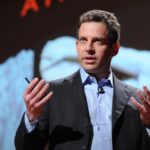
https://pi.tedcdn.com
Sam Harris, on his phenomenal podcast, has frustratedly joked:
“How is it that we are in this situation. I mean, we are getting ready to colonize Mars and we cannot agree on what would be healthy food to take for the trip.”
There is certainly a collective “uch, I know!” That follows when Harris makes this “funny-but-true” comment. But he may also be overstating the case.
It appears the answer to the question, “why does this only happen in nutrition and not other sciences” has three distinct explanations:
Explanation #1: It does occur in other sciences. It might be, for instance, that nutrition just seems to lack more clarity given we deal with it everyday and it seems like the type of thing that should be easily sorted out (it’s not). Other sciences, like astrophysics, also do not know extremely important things, we are just not focused on them on a daily basis.
Consider dark matter. According to a Ph.D in this Forbes article:
“Yes, earth is surrounded by dark matter particles, though they’re probably a bit sparse in the solar neighborhood. Dark matter particles are moving through your body, and the whole earth, unnoticed as we speak. We know there must be a lot more dark matter than Baryonic (normal) matter”.
However, “here’s what we do not know about dark matter: what it actually is.”
But we don’t eat dark matter for breakfast every morning (I think..?), so we don’t realize there is lack of knowledge.
Explanation #2: Nutrition Science is uniquely hard. As nutrition journalist, Michael Pollan, in his book, In Defense of Food noted: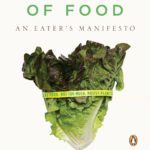
“To understand how nutrition science could have been so spectacularly wrong about dietary fat and health, it’s important to understand that doing nutrition isn’t easy. In fact, it’s a lot harder than most scientists who do it for a living realize or at least are willing to admit.”
I will get into why it is so hard in a future post. For now, suffice it to say, there are tons of challenges.
Explanation #3: Where are you getting your information? Nutrition can be massively confusing, but it can also be massively profitable to take a controversial stance.
In nutrition science, there is a huge and apparent difference between the people who report to (and sell) the public on what we “know,” and the people actually doing the research. I.e. The people in the actual lab coats torturing rats with Bunsen burners.
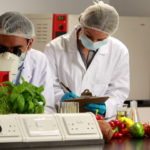 The people who report the issues to the public via their books and protein shakes and superfood green powders (think this guy) I will refer to as the “Public Interfacers.” The people (dweebs) who are actually in the labs trying to figure this thing out I will refer to as the “Researchers.”
The people who report the issues to the public via their books and protein shakes and superfood green powders (think this guy) I will refer to as the “Public Interfacers.” The people (dweebs) who are actually in the labs trying to figure this thing out I will refer to as the “Researchers.”
Notwithstanding what the Public Interfacers might tell you, it seems that the  Researchers actually do agree on a lot more than we’ve been led to believe.
Researchers actually do agree on a lot more than we’ve been led to believe.
Key Takeaway: Nutrition science may be uniquely hard to perform, but then, most sciences seem to have their difficulties. However, there may be additional, and more pressing, problems caused by the obscuring of what we actually DO know and agree on via the False Positive.
Now, this problem is also not all the fault of the Researchers and the Public Interfacers. It may equally be the fault of… me, myself…and, of course… Irene. I mean, us.
#4: How To Navigate: Venn Diagrams, Traffic Lights, and Bayes
“If we learn to treat all our beliefs as initial guesses with particular probabilities associated with them, then we can welcome new evidence as an opportunity to get closer to seeing the world the way it actually is.” Al Pittampalli, Persuadeable.
Taking from other sciences (and high school), the most useful approach seems to be the following:
- Establish a categorization system or rubric (I love rubrics) and then,
- Use the “Bayesian” approach to adjust moving forward
Ok, so first the rubric (imagine I just slapped your hand with a ruler).
As Dr. David Katz (True Health Initiative Founder) has said:
“True experts may differ about their preferred set of details, and may tend to talk about those predominantly, because it is the controversies at the edge of what we know that interest experts most. But ask them about the fundamentals, and the vast expanse of common ground is suddenly revealed.”
Ah…a silver lining!!! Yay!
As Dr. Katz points out, there do appear to be consistencies amongst all of the experts – whether Paleo, low-carb, ketogenic, Jenny Craig, or those pesky vegans (I am one, currently, so I can say “pesky.” It’s like a Jew making Jew jokes.)
But of course, there are also inconsistencies. The trick seems to be just put those on paper.
We’ve already talked about a rubric, we might as well round out the grade-school vocab with a Venn Diagram! Like that handwriting? Yes, I have the penmanship of a small child.
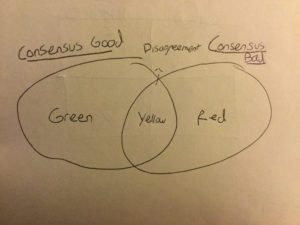
Split the consistencies into good and bad. On the left, things we know are good (“consensus good” in the picture). On the right, things we know are bad (“consensus bad”). In the middle, the inconsistencies (“disagreement”). These are things that we disagree about. The research in this area, from what I gather from the “experts” are unclear.
[Note, things we “know” here are as good as we can tell from science. These are what the majority of researchers agree on. If there are notable detractors, I will point them out.].Now, to steal (like an artist) an idea from Dr. Michael Greger, view the VD (Venn Diagram, not venereal disease) as a sideways traffic light. The good are green, the disagreed upon foods are yellow and the bad are red. Green means go, yellow means proceed with caution and red means… well, you get how a traffic light works.
In terms of what actually should be placed where inside our awesome Venn Diagram – that’ll have to wait until next time… We will start on the Green.
And, not surprisingly, a lot of the foods that comprise the green “traffic light” would camouflage. Get it? Translation: Popeye had a point. So for now, maybe add another serving or two of spinach or, yes, kale, to your weekly repertoire.
After you have your Venn Diagram of what we believe what food is good bad and indifferent, we then apply the Bayesian approach. That is, as new evidence is uncovered or presented to us, we adjust our beliefs accordingly to the new weight of that evidence.
In Persuadable, the author suggests a three strike rule. After three pieces of counter-evidence, you should really consider changing your belief. I see no need to put a number on it, but if that helps you, go for it.
Key Takeaway: To decide what to eat, we need a framework. We can use a Venn Diagram to place the agreed upon good foods on one side, the agreed upon bad on the other, and everything else in the middle. We then simply tend towards the left side. From there, we used Bayes, adjusting what goes in each part by how convincing the evidence is.
To Sum Up… “You Look Young, We’re Having Fun..“
-
Awareness is key. False Positives make us particularly vulnerable to act on the basis of delusions – either our own or that of experts. Science and Philosophy operate based on this premise.
-
The Nutrition Problem is real and immediate. I wouldn’t wait until geezer status to act on this bad boy. Unless, you know, you want a bad brain.
-
Nutrition science has its issues, but so do most sciences. Nutrition might be further pronounced because of the rampant False Positive-Toting, Public Interfacers.
-
Using A Framework. We need to understand how to navigate. To do that, we need a map – or in my case, Venn Diagrams and Traffic Lights. Then move forward based on how convincing future evidence is – and not be afraid to change our beliefs.
That’s all for now.
Next time, I’ll get more into what foods fill out that Venn Diagram.
Until then — I guess just fast or something…
Ok, don’t do that. Eat greens.
Besos,
Justin
[Click here to read on about the Consensus Green-Light Foods and Red-Light Foods]
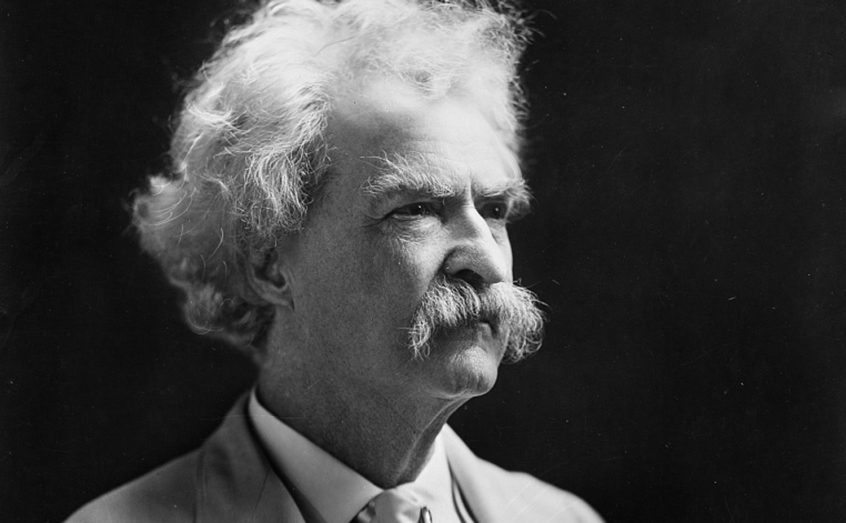
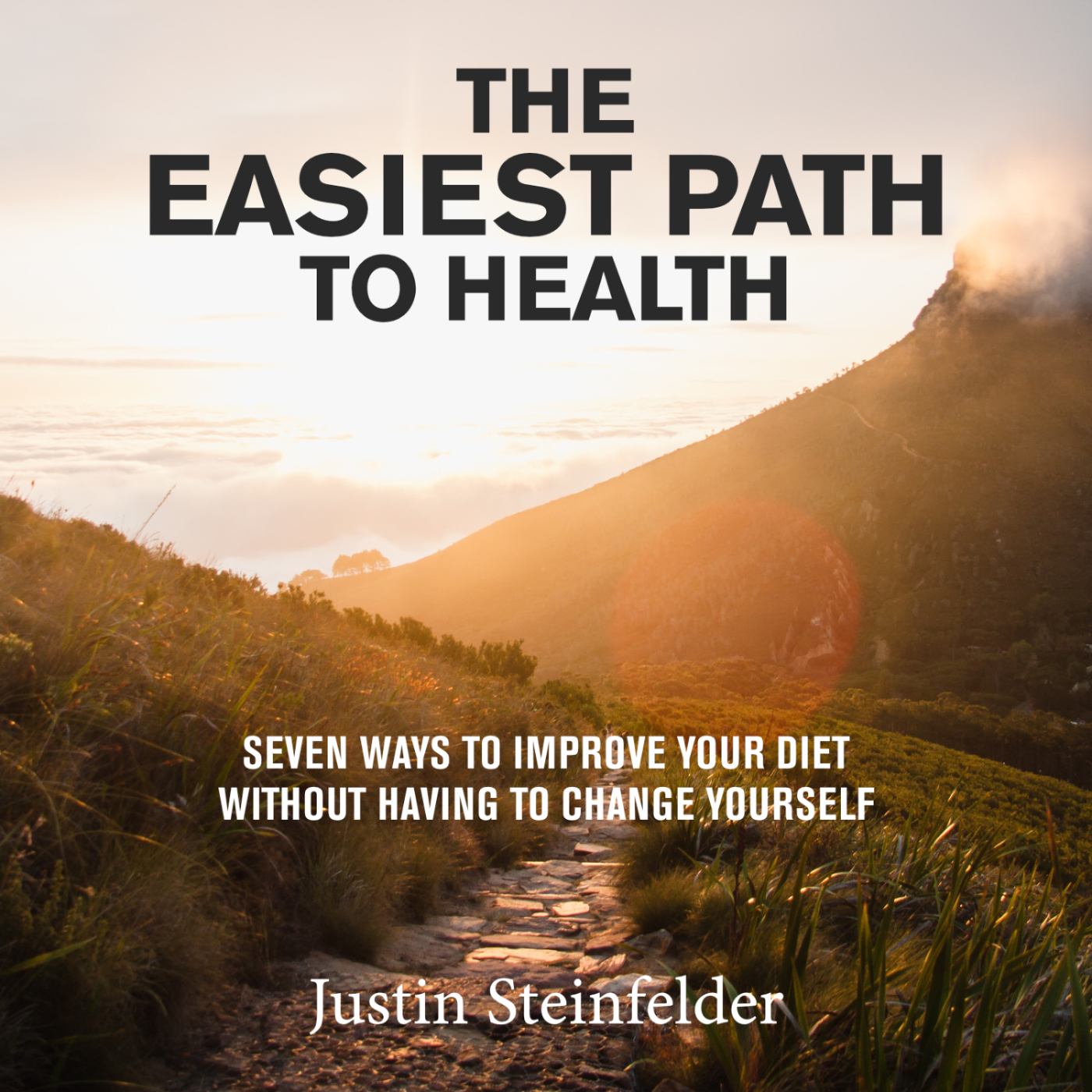

4 Comments on “Navigating Nutrition: Lessons From Twain and Socrates”
you said it would take about 15 minutes to read and it took me almost 30…does that say more about your estimate or my reading ability? also, would Quest Bars go under the green, yellow or red category?
Whoops. Forgot to incorporate time for all of the links. Haha. Hmm – with respect to Quest- I’ll have to place them in the Yellow at best.
You are too smart for me! What about supplements and vitamins? Also, what if you already have chronic illnesses? Can proper nutrition make a difference then?
How do you have time to read all those books?
The Mommy
Took me 8 minutes but I skipped all the links:)